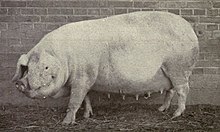The Danish Landrace, Danish: Hvid Dansk Landrace, is a Danish breed of pig. It is of medium to large size, white in colour with a long body, fine hair, a long snout, and heavy drooping ears. There are two distinct varieties, the white (hvid) and the piebald (sortbroget).
 Sow, photograph from 1909 | |
| Conservation status | |
|---|---|
| Other names |
|
| Country of origin | Denmark |
| Traits | |
| Weight | |
| Height |
|
| |
History
editDuring the second half of the nineteenth century, Denmark became a major supplier of bacon to the United Kingdom: exports grew from 1000 tons per year in 1850 to 50000 in 1900; they grew still further in the twentieth century, reaching 384000 in 1932.[3]: 586 From about 1865, and particularly between 1879 and 1896, breeding stock of the British Large White or Yorkshire breed was imported and cross-bred with local animals to supply the bacon trade. The cross of a Large White boar with a sow of the traditional Jutland breed was found to be particularly successful.[3]: 587
In 1896 the Danish government drew up a national plan for pig production, under which the Large White x Jutland hybrid would become a new breed, the Danish Landrace.[3]: 587 A herd-book published in 1906 listed 126 boars born from 1893 to 1904;[3]: 587 some 60% of them were from Jutland, 21% from Fyn and 10% from Zealand. Performance testing was started in 1899.[4]: 121 Herds of purebred local and Large White pigs were separately reared; farmers could buy stock to produce the first-generation hybrid, which soon became the predominant pig of Denmark. From about 1925 the use of Large White boars was reduced, and the new breed selectively bred for characteristics including more length in the body and less fat on the back.[3]: 587
After the end of the Second World War, limits were placed on exports of breeding stock; the Danish Landrace had already been exported to many countries of the world, and had given rise to numerous regional breeds, among them the American, Dutch Landrace, Norwegian, South African and Swedish Landrace.[3]: 587 [5]: 404
In the 1960s it was essentially the only pig breed in the country, but in the 1970s it came to be considered insufficiently productive for intensive farming.[3]: 587 A comparison with imported Large White in 1977 found it to grow more slowly while consuming more feed.[6] From about this time it was cross-bred with newly-imported Large White boars to create the Dan-Hybrid sow line, on which a variety of Duroc, Hampshire and Large White boars were used.[3]: 587 By 1983 approximately 3500 of the original breed remained.[3]: 587
Characteristics
editThe Danish Landrace is a medium-to-large, long, lean, pig. It is white, and is scantily clad with short hairs. The snout is long, and the large ears droop forwards. It has deep flanks and lacks the wrinkles and excess fat found in some other breeds.[7]
References
edit- ^ Barbara Rischkowsky, Dafydd Pilling (editors) (2007). List of breeds documented in the Global Databank for Animal Genetic Resources, annex to The State of the World's Animal Genetic Resources for Food and Agriculture. Rome: Commission on Genetic Resources for Food and Agriculture, Food and Agriculture Organization of the United Nations. ISBN 9789251057629. Archived 23 June 2020.
- ^ a b c d Breed data sheet: Dansk Landrace / Denmark (Pig). Domestic Animal Diversity Information System of the Food and Agriculture Organization of the United Nations. Accessed May 2022.
- ^ a b c d e f g h i Valerie Porter, Lawrence Alderson, Stephen J.G. Hall, D. Phillip Sponenberg (2016). Mason's World Encyclopedia of Livestock Breeds and Breeding (sixth edition). Wallingford: CABI. ISBN 9781780647944.
- ^ Valerie Porter (1993). Pigs: A Handbook to the Breeds of the World. Mountfield, East Sussex: Helm Information. ISBN 9781873403174.
- ^ Hilton Marshall Briggs, Dinus M Briggs (1980). Modern Breeds of Livestock, fourth edition. New York: Macmillan. ISBN 9780023147302.
- ^ Børge Laursen, Poul Jensen (2 May 1977). Meddelelse Nr. 167: Vækst og foderudnyttelse hos grise af Dansk Landrace og Yorkshire i den tidlige del af vækstperioden (in Danish). Statens Husdyrbrugsforsøg. Accessed May 2022.
- ^ Hilton Marshall Briggs (1983). International Pig Breed Encyclopedia. Indianapolis, Indiana: Elanco Products.